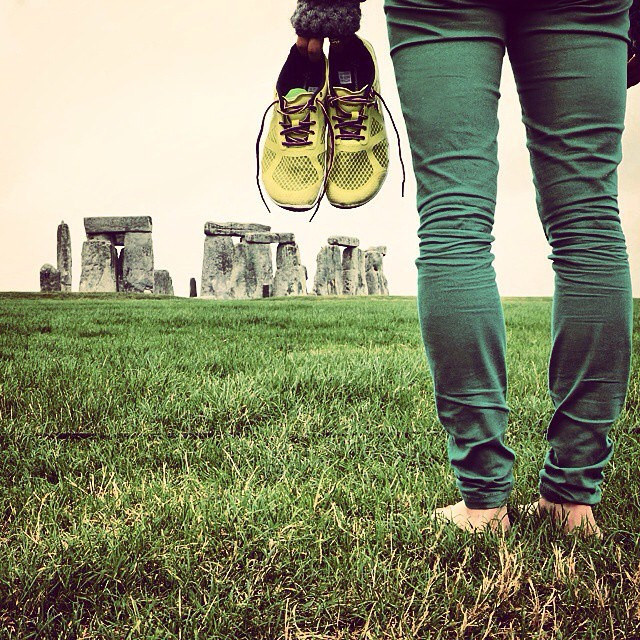
“A good strong foot is an adaptable foot. It can adapt to a wide range of conditions. Everything from barefoot to wearing a really bad shoe. And everything in between. A healthy foot in a bad shoe is more functional than an unhealthy foot in the most well-designed shoe in the world. Do something to recondition your foot.” ~ Leslie Kaminoff
~
About 20 years ago, I had several problems with my feet.
They were not strong. I couldn’t stand or walk for long periods of time because I got severe foot aches. I had surgery to correct some of the problems—and as a result of the surgery, one of my toes now overlaps another.
After the surgery, I started practicing yoga. As time went by, I began to realize that my foot problems had completely disappeared. I could stand for long periods of time and walk long distances, and my feet didn’t bother me. I could rely on them. And I didn’t need special soles or cushioned shoes.
As part of my yoga training, I took Leslie Kaminoff’s and Amy Mathews’ online yoga anatomy course. They helped me see how nature had done such an extraordinary job of engineering our feet. They do so much for us each day, and it’s essential for our feet to be strong and well-conditioned in order for them to be functional.
After years of not having a good relationship with my feet, I fell in love with them. I came to understand how practicing yoga could help them.
We practice yoga barefoot.
Being barefoot strengthens the muscles in our feet because we no longer have the support of shoes. It conditions them.
Our feet have evolved over millions of years to be in direct contact with the earth. For the greater part of human history, man went about barefoot. It’s been a relatively short time since we have been walking around in shoes and on smooth, paved surfaces.
In the book Born to Run by Christopher McDougall, the author cites Irish physical therapist, Gerard Hartmann Ph.D. McDougall says Hartmann, “serves as the great and powerful Oz for the world’s finest distance runners.” Hartmann argues that putting our feet in shoes is the equivalent to putting them in a plaster cast, resulting in musculature atrophy.
“When shoes are doing the work, tendons stiffen and muscles shrivel.” ~Gerard Hartmann Ph.D.
“…[T]he deconditioned musculature of the foot is the greatest issue leading to injury, and we’ve allowed our feet to become badly deconditioned.” ~ Gerard Hartmann Ph.D.
McDougall also cites Dr. Paul W. Brand, chief of rehab at United States Public Service hospital in Louisiana and professor of surgery at Louisana State University Medical School:
“We could wipe out every common foot ailment within a generation by kicking off our shoes.”
That is precisely what yoga requires us to do: kick off our shoes and practice barefoot.
Yoga teaches us to pay attention to our feet.
Most of the time, we go about life without being conscious of our feet, except when they are bothering us.
Just like a good foundation is necessary in the construction of a house or a building, the same thing applies in an asana (yoga pose). When entering an asana, it’s always important to start with a solid base of support. For example, in standing asanas, it is the feet.
How are the feet placed? Parallel? At an angle? With a wider or narrower stance? Where is the weight of the body being held them? Our awareness of how we place and use our feet increases when we practice yoga.
Yoga teaches us to distribute the weight of our body evenly on our feet. And to ground them.
We have three structural places in the bones of our feet that make contact with the supporting surface on which we stand: the calcaneal tuberosity (bump in our heel), the distal end of the fifth metatarsal (the base of the little toe), and the distal end of the first metatarsal (the base of the big toe). These three points form a triangle.
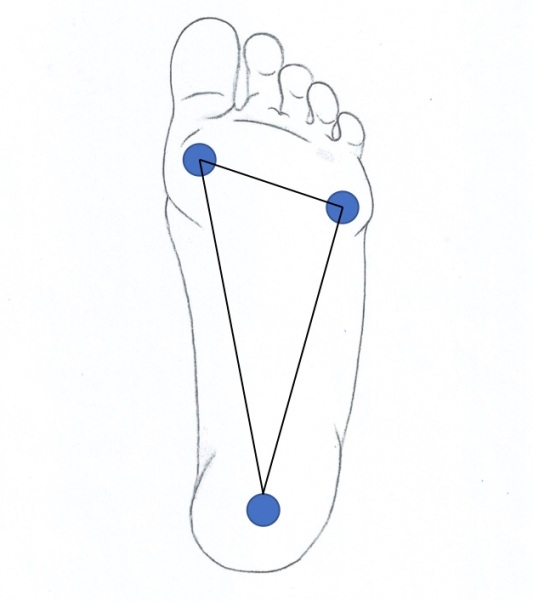
The basic structure of our feet is that of a tripod, and as such, it can stand on any kind of uneven surface without wobbling. Something that stands over two points or four points has difficulty balancing on uneven surfaces. Kaminoff says that the tripod structure makes our feet “an all-terrain vehicle.”
Sometimes, our weight tends to go to the back of our foot, or to the front, on one side or the other. If we observe how our shoes are worn out, we can easily see where we tend to place the weight of our body in our feet.
In the different standing asanas we learn to return the weight to the center, distributing it evenly on these three points of support.
For example, in an asana like Trikonasana (Triangle Pose), the external hip rotation in the front leg might cause the weight of the foot to shift to the external side. If this happens, pressing down the mound of the big toe can help even the distribution of the weight of the body on that foot.
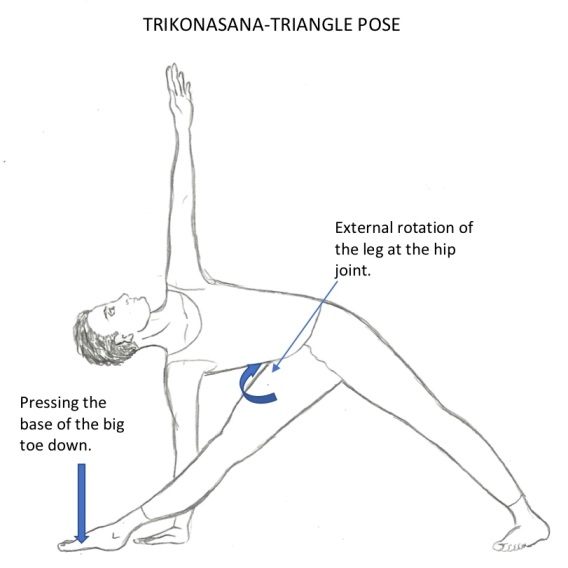
In a pose such as Virabhadrasana I (Warrior I), sometimes the weight on the back foot tends to come to the front inner part of it. If this happens, pressing the heel and the base of the little toe down can help even the distribution of the weight on that foot.

Weight that is well-distributed on the base of support gives the pose firmness and stability.
Yoga strengthens our feet in several ways:
>> By practicing barefoot.
>> By aiming to distribute the weight of our body evenly on the three points of support of our feet. And at the same time, pressing these three points down to ground our feet.
>> In standing balance poses like Utthita Padangusthasana I, we tend to shift the weight on our standing foot from one side to the other until we find balance. This strengthens and conditions our feet.
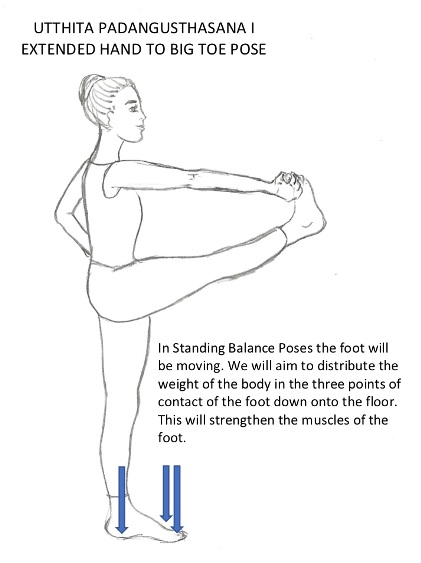
>> In standing asanas, we can lift some or all of our toes off the floor.
>> While sitting or lying down in asanas, we can activate our feet or do specific exercises like flexing and pointing, and moving toes in different directions. This helps to strengthen and increase the flexibility in our feet.
>> Doing foot exercises with balls like the ones used in Yoga Tune Up (yoga fitness therapy) are also great to strengthen and condition the feet.
The arches of our feet receive the upward support of the earth and send that energy up through our body.
There are three arches in our feet, formed by the lines that connect the three points of contact to each other.
The medial longitudinal arch is the big arch on the inside of our foot, the arch on the external side is the lateral longitudinal arch, and the one crossing the front of the foot is the transverse or metatarsal arch.
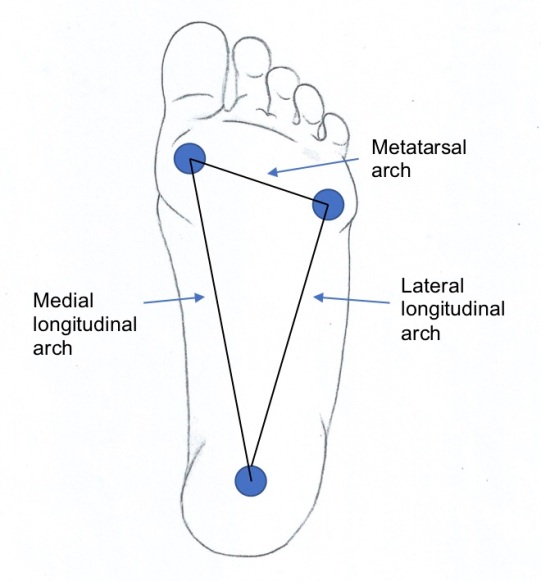
Kaminoff mentioned in his anatomy course that the earth has a gravitational field that pulls every molecule in our body toward the center (gravity). Newton’s third law of physics, says that for every action, there’s an equal and opposite reaction.
So, just as much as our bodies are pushing down into the earth with our weight due to gravity, there’s an equal ground reaction force that’s pushing up, into, and through our body. This force is the support that the earth gives us.
After pressing the points of contact of the foot down on to the supporting surface, the arches of our feet receive this ground reaction force. That’s why grounding our feet sometimes feels like we are receiving a surge of energy that moves up through our body.
In Annie Carpenter’s 2018 yoga teacher training in Oakland, California, she said the following:
“A small movement, like changing the weight in some part of our body, can have great repercussions on other parts and on our energy.”
In my daily life, I tend to carry the weight of my body on the external part of my feet—more toward the outer heel and base of the little toe. After listening to Annie, I started with an exploration: what would happen if, instead of rolling my feet toward the outside, I shifted the weight more toward the base of the big toe? To my surprise, my tendency to tuck my pelvis automatically corrected itself and my lumbar spine regained its natural curve.
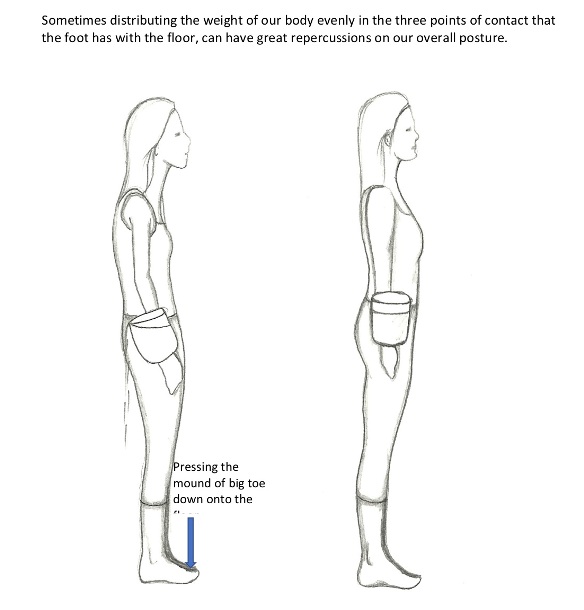
It’s really surprising what distributing the weight of our body evenly on our feet can do to our overall posture and energy.
In my experience, yoga was the solution for my multiple foot problems. It’s difficult, to say the least, to go through life with foot aches. I thought the solution was in surgery, cushioned shoes, or special soles. I wanted to fix my feet. I thought they were a part of my body that didn’t function as they should.
But, they really didn’t need fixing—they were already wonderfully engineered by nature. They needed attention, strengthening, and conditioning. Yoga did all that for me.
“Just look at the architecture. Blueprint your feet, and you’ll find a marvel that engineers have been trying to match for centuries.” ~ Christopher McDougall
~
Sources:
McDougall, Christopher. Born to Run. Vintage, 2009.
Leslie Kaminoff and Amy Mathews’ online Yoga Anatomy Courses, Principles, and Practices.
Annie Carpenter. Sama Sadhana Teacher Training.
~
Author: Lucia Rodriguez
Images: VIVOBarefoot/Flickr; Author’s Own
Editor: Catherine Monkman
Copy & Social Editor: Khara-Jade Warren








Read 10 comments and reply